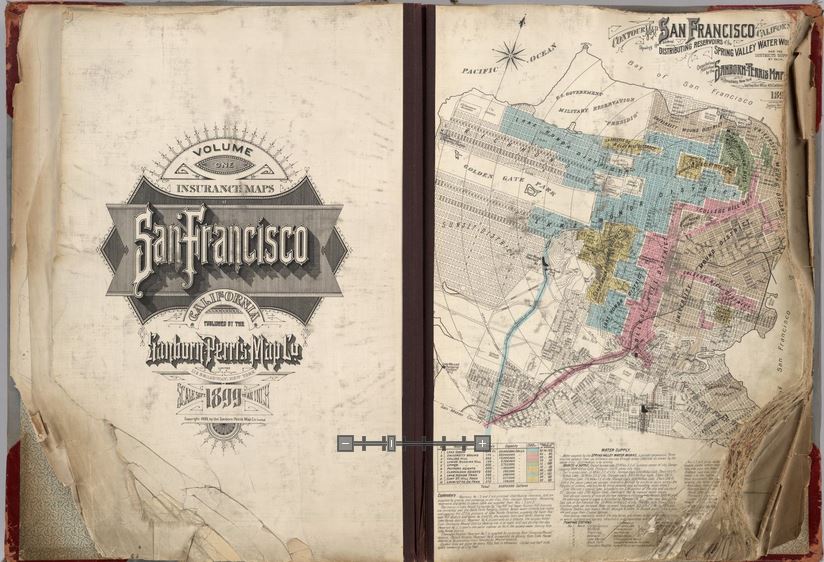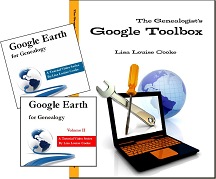by Lisa Cooke | May 8, 2013 | 01 What's New, Maps

Opening pages of rare 1905 Sanborn Map of San Francisco, showing city just before 1906 earthquake. Find the entire map book at the David Rumsey Historical Map Collection
Genealogists rely on historical maps to help us navigate the geography of our ancestors’ lives. One of the most important resources available online is the David Rumsey Map Collection. Well, Rumsey recently announced on his website that he will be making more than 38,000 of his historical maps–everything he’s currently got online–available at the Digital Public Library of America (DPLA).
I blogged recently about the DPLA, which aims to create an enormous, free digital library we can all access online. It will be great to have the Rumsey map collection searchable on the DPLA so we can search these maps while we look for any other sources on any particular location our ancestors lived. “Maps tell stories that complement texts, images, and other resources found in the growing DPLA library,” says Rumsey. “And the open content policies of my online library fit perfectly with DPLA’s mission to make cultural resources freely available to all.” He applauds what the DPLA is trying to accomplish and even encourages other collectors to donate content.
Rumsey has spent years collecting thousands of old maps and putting them online. Now he’s working to share them even more widely. His entire collection of about 150,000 maps will eventually be housed at Stanford University. Meanwhile, we can all enjoy the thousands of images we can search on his site or at the DPLA.
Google’s free program Google Earth includes nearly 150 historic maps in the Layers panel. You can also add historic maps downloaded from Rumsey’s site to Google Earth by using the Overlay feature. My video tutorial series called Google Earth for Genealogy will show you how. You can also get step-by-step instructions in my book The Genealogist’s Google Toolbox. Or get them all in a discounted bundle.
by Lisa Cooke | Dec 4, 2013 | 01 What's New, Digital Archives
 I’ve blogged before about the relatively new Digital Public Library of America (here’s a post introducing the DPLA and here’s one on historical maps you’ll find there). Now the Library of Congress has posted a 31-minute webcast that features the DPLA content director, Emily Gore. She not only demonstrates some great examples of what you can find in the public portal of the DPLA, but also discusses the potential for gathering even more materials (she gives an example using local sources.) It’s a great introduction to the site, and Gore answers some questions from the audience that seem to be on a lot of people’s minds.
I’ve blogged before about the relatively new Digital Public Library of America (here’s a post introducing the DPLA and here’s one on historical maps you’ll find there). Now the Library of Congress has posted a 31-minute webcast that features the DPLA content director, Emily Gore. She not only demonstrates some great examples of what you can find in the public portal of the DPLA, but also discusses the potential for gathering even more materials (she gives an example using local sources.) It’s a great introduction to the site, and Gore answers some questions from the audience that seem to be on a lot of people’s minds.
Looking for a more basic intro to the DPLA? Check out this introductory video, too.
by Lisa Cooke | Apr 1, 2013 | 01 What's New, NARA
The National Archives announced recently that it will help with the first pilot project of the Digital Public Library of America (DPLA).
According to the National Archives’ press release, “The DPLA is a large-scale, collaborative project across government, research institutions, museums, libraries and archives to build a digital library platform to make America’s cultural and scientific history free and publicly available anytime, anywhere, online through a single access point.
“The DPLA is working with several large digital content providers – including the National Archives and Harvard University – to share digitized content from their online catalogs for the project’s two-year Digital Hubs Pilot Project. This pilot project is scheduled to launch on April 18-19, 2013 at the Boston Public Library, which will host an array of festivities, including presentations and interactive exhibits showcasing content from the DPLA’s content partners. The DPLA will include 1.2 million digital copies from the National Archives catalog, including our nation’s founding documents, photos from the Documerica Photography Project of the 1970’s, World War II posters, Mathew Brady Civil War photographs, and documents that define our human and civil rights.”
If you’re like me, you’re wondering what genealogically-interesting documents will have a home on the DPLA. There’s a great blog post on the DPLA site that talks about partnerships with state and regional digital libraries, including the Kentucky Digital Library, which has more than 800,000 page s of newspapers, and over half a million pages of “books, photographs, archival materials, maps, oral histories and pages of other paginated publications.”
s of newspapers, and over half a million pages of “books, photographs, archival materials, maps, oral histories and pages of other paginated publications.”
NOW we’re talking! The DPLA will certainly be a resource worth watching!




